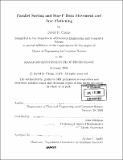Parallel sorting and Star-P data movement and tree flattening
Author(s)
Cheng David R. (David Rolin)
DownloadFull printable version (3.753Mb)
Other Contributors
Massachusetts Institute of Technology. Dept. of Electrical Engineering and Computer Science.
Advisor
Alan Edelman.
Terms of use
Metadata
Show full item recordAbstract
This thesis studies three problems in the field of parallel computing. The first result provides a deterministic parallel sorting algorithm that empirically shows an improvement over two sample sort algorithms. When using a comparison sort, this algorithm is 1-optimal in both computation and communication. The second study develops some extensions to the Star-P system [7, 6] that allows it to solve more real problems. The timings provided indicate the scalability of the implementations on some systems. The third problem concerns automatic parallelization. By representing a computation as a binary tree, which we assume is given, it can be shown that the height corresponds to the parallel execution time, given enough processors. The main result of the chapter is an algorithm that uses tree rotations to reduce the height of an arbitrary binary tree to become logarithmic in the number of its inputs. This method can solve more general problems as the definition of tree rotation is slightly altered; examples are given that derive the parallel prefix algorithm, and give a speedup in the dynamic programming approach to the computation of Fibonacci numbers.
Description
Thesis (M. Eng.)--Massachusetts Institute of Technology, Dept. of Electrical Engineering and Computer Science, 2005. Includes bibliographical references (p. 81-84).
Date issued
2005Department
Massachusetts Institute of Technology. Department of Electrical Engineering and Computer SciencePublisher
Massachusetts Institute of Technology
Keywords
Electrical Engineering and Computer Science.